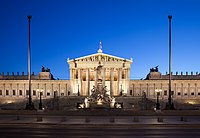Federal Assembly of Vierzland
This article is incomplete because it is pending further input from participants, or it is a work-in-progress by one author. Please comment on this article's talk page to share your input, comments and questions. Note: To contribute to this article, you may need to seek help from the author(s) of this page. |
Federal Assembly Bundesversammlung | |
|---|---|
 | |
| Type | |
| Type | |
| History | |
| Established | 4 January 1992 |
| Preceded by | Imperial Council (1766–1990) Reichsthing (1795–1990)
|
| Leadership | |
Eva Weiskopf (NDP) since 2 March 2017 | |
| Structure | |
| Seats | 745 |
 | |
Political groups | Government (433)
Opposition (312)
|
| Elections | |
| Mixed-member proportional representation (MMP) | |
Last election | 14 January 2017 |
Next election | 15 January 2022 |
| Meeting place | |
 | |
| Ehrepalast Adtrus, Vierzland | |
| Website | |
| www.bv.vz | |
The Federal Assembly of Vierzland (Vierz: Bundesversammlung Vierzlands), officially the Federal Assembly of the Vierz Federation (Vierz: Bundesversammlung der Vierze Föderation), is the federal, unicameral legislature of Vierzland. The legislature has 745 members elected by mixed-member proportional representation under universal suffrage for all citizens 18 years of age or older. Elections have fixed-terms of five years and occur on the second Saturday of January.
The Federal Assembly was created under Chapter II of the Constitution of Vierzland, with its first elections held in 1992. It is situated in Adtrus in the Ehrepalast, which housed the Reichsthing from 1857 to 1990. The Federal Assembly is led by a President and any number of Vice Presidents, who are elected by a simple majority on the day of a new legislature's inauguration.
Since the abolition of the presidency in 1998, solely the Federal Assembly elects the Chancellor, which occurs directly thereafter the inauguration of a new legislature. Every chancellor since 1992 has also been the leader of the largest party in the Federal Assembly, although this is not constitutionally mandated.
With the establishment of an entirely parliamentary system in 1990, the Federal Assembly has seen a plurality of parties represented. Currently, there are six parties with seats in the legislature; two of those parties are included in the governing coalition – the United Front.